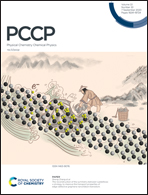Ti2P monolayer as a high performance 2-D electrode material for ion batteries†
Abstract
Electrical conductivity, storage capacity and ion diffusion ability are three crucial parameters for battery electrode materials. However, rare existing two-dimensional (2-D) electrode materials can achieve high performances in all these parameters. Here, we report that a 2-D transition-metal phosphide, the Ti2P monolayer, is a promising superior electrode material which realizes high performances in all the parameters mentioned above. The Ti2P monolayer has a stable honeycomb crystal structure. It has a metallic electronic structure with Li/Na adsorption, which ensures good electrical conductivity during the battery operation. We find that Li/Na can chemically bond to the Ti2P substrate, with specific charge exchanges. Our results show the Li/Na capacity in the Ti2P monolayer is about 846 mA h g−1, which is much higher than that of the graphite anode. Remarkably, the Li/Na diffusion barrier on the Ti2P monolayer is only 12–16 meV, which is lower than that in all 2-D anode materials proposed till now. Our work highly promises that theTi2P monolayer can serve as a superior anode material for Li-ion/Na-ion batteries by providing good electrical conductivity, high storage capacity and ultrafast ion diffusion.



 Please wait while we load your content...
Please wait while we load your content...